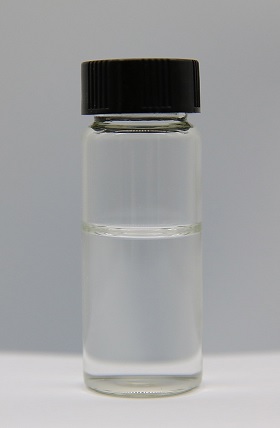| Uses | As broad-spectrum antimicrobial cold sterilant/disinfectant for hospital equipment; as tanning agent for leather; as tissue fixative; as cross-linking agent for proteins; as preservative in cosmetics; as therapeutic agent for warts, hyperhidrosis, and dermal mycotic infections; in X ray processing solutions and film emulsion; as a disinfectant in the beauty industry
|
| Description | Glutaraldehyde is a well-known sensitizer among
cleaners and health workers. It is also found in X-ray
developers products.
|
| Chemical Properties | Glutaraldehyde is a colorless liquid with a pungent odor, which readily changes to a glossy polymer. The Odor Threshold is 0.04 ppm (NY) and 0.2 ppm (NJ). It is miscible in water and organic solvents. Glutaraldehyde may be incompatible with strong oxidizers and strong bases. It should be noted that alkaline solutions containing glutaraldehyde may react with alcohol, ketones, amines, hydrazines, and proteins.

|
| Uses | glutaral (glutardialdehyde) is a broad-spectrum preservative that can cause skin irritation. This is an amino acid occurring in green sugar beets. |
| Uses | Glutaraldehyde (Symbol GTA; glutaric dialdehyde, 1,5-pentanedial, glutaral) is commonly used in the medical industry in cold sterilization and in the X-ray development process. It can also be encountered in the leather industry as a tanning ingredient and in mortuary workers. There are no reports which indicate that glutaraldehyde is a naturally occurring compound. Cidex and Acusol, 2% buffered solutions, use this aldehyde as an active ingredient. Sodium bicarbonate is required to activate the solution, which then has a shelf life of 1–2 weeks. Despite health hazards involved with its use, glutaraldehyde is one of the most effective biocides used. It is particularly effective against bacteria and viruses, including the human immunodeficiency virus. |
| Uses | Glutaraldehyde is used to disinfect medical and dental equipment. Glutaraldehyde is also used for industrial water treatment and as a preservative. |
| Uses | Glutaraldehyde is used as a cold sterilizingdisinfectant, as fixatives for tissues, in tanning,and in cross-linking proteins. |
| Definition | ChEBI: A dialdehyde comprised of pentane with aldehyde functions at C-1 and C-5. |
| Synthesis Reference(s) | Tetrahedron, 48, p. 3503, 1992 DOI: 10.1016/S0040-4020(01)88489-1 |
| General Description | Light yellow liquid. Mixes with water. |
| Air & Water Reactions | Polymerizes in the presence of water. |
| Reactivity Profile | GLUTARALDEHYDE may discolor on exposure to air. Pentanedial polymerizes on heating. Pentanedial is incompatible with strong oxidizing agents. Pentanedial polymerizes in the presence of water. |
| Health Hazard | Glutaraldehyde is a strong irritant to the nose,eyes, and skin. In rabbits, 250 μg and 500 mg in 24 hours produced severe irritation in theeyes and skin, respectively. The corrosiveeffect on human skin of 6 mg over 3 dayswas severe. However, the acute toxicity ofglutaraldehyde by the oral and dermal routesis low to mild. Ohsumi and Kuroki (1988)determined that the symptoms of acute toxicityof this compound were less severethan those of formaldehyde. But the restraintof growth was more pronounced in micetreated with glutaraldehyde. An oral LD50value of 1300 mg/kg was reported for mice.Inhalation of this compound can cause upperrespiratory tract irritation, headache, and nervousness.Mice exposed at 33 ppm showedsymptoms of hepatitis. |
| Fire Hazard | Literature sources indicate that Pentanedial is nonflammable. |
| Flammability and Explosibility | Nonflammable |
| Biochem/physiol Actions | Glutaraldehyde is an effective protein crosslinker and finds application in techniques like enzyme immobilisation microscopy, histochemistry and cytochemistry. It exists in different forms under acidic or neutral conditions. It is a biocide widely used as a disinfectant in hospitals and industries and is toxic to aquatic organisms. Its allergic nature leads to hypersensitivity reactions. Contact of glutaraldehyde vapors in endoscopy contributes to Colitis. |
| Contact allergens | Glutaraldehyde is a well-know sensitizer in cleaners
and health workers. It can also be found in X-ray
developers or in cosmetics. |
| Safety Profile | Poison by ingestion,
intravenous, and intraperitoneal routes.
Moderately toxic by inhalation, skin contact,
and subcutaneous routes. Experimental
teratogenic and reproductive effects. A
severe eye and human skin irritant. Mutation
data reported. When heated to decomp osition it emits acrid smoke and irritating
fumes. See also ALDEHYDES. |
| Potential Exposure | Glutaraldehyde is used in leather
tanning; in embalming fluids; as a germicide; as a
cross-linking agent for protein and polyhydroxy materi als; as a fixative for tissues; and as an intermediate.
Buffered solutions are used as antimicrobial agents in
hospitals. |
| Shipping | UN2810 Toxic liquids, organic, n.o.s., Hazard
Class: 6.1; Labels: 6.1-Poisonous materials, Technical
Name Required. |
| Purification Methods | Likely impurities are oxidation products-acids, semialdehydes and polymers. It can be purified by repeated washing with activated charcoal (Norit) followed by vacuum filtration, using 15-20g charcoal/100mL of glutaraldehyde solution. Distil it at 60-65o/15mm, discarding the first 5-10%, then dilute with an equal volume of freshly distilled water at 70-75o, using magnetic stirring under nitrogen. The solution is stored at low temperature (3-4o), in a tightly stoppered container, and protected from light. Standardise by titration with hydroxylamine. [Anderson J Histochem Cytochem 15 652 1967, Beilstein 1 IV 3659.] |
| Incompatibilities | Water contact forms a polymer solution.
A strong reducing agent. Incompatible with strong acids;
caustics, ammonia, amines, and strong oxidizers. Note:
Alkaline solutions of glutaraldehyde (i.e., activated glutar aldehyde) react with alcohol, ketones, amines, hydrazines,
and proteins. |
| Waste Disposal | Dissolve or mix the material
with a combustible solvent and burn in a chemical incinera tor equipped with an afterburner and scrubber. All federal,
state, and local environmental regulations must be observed. |



